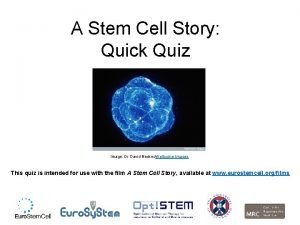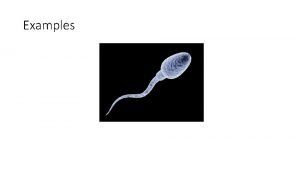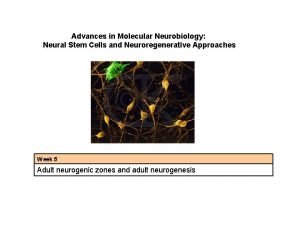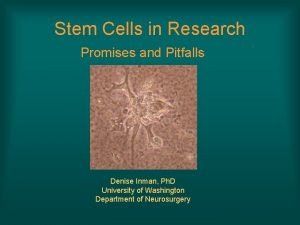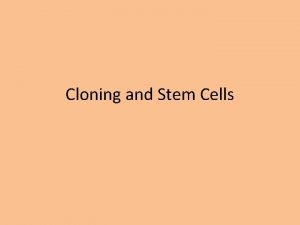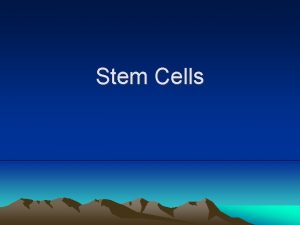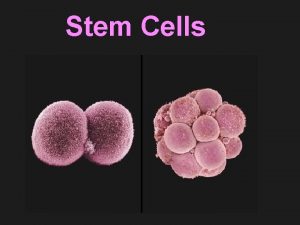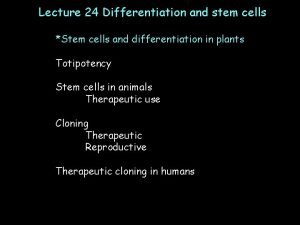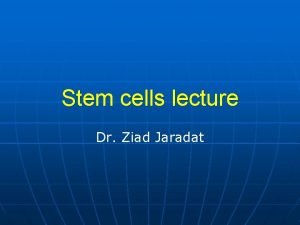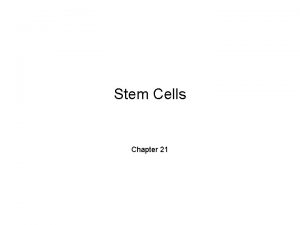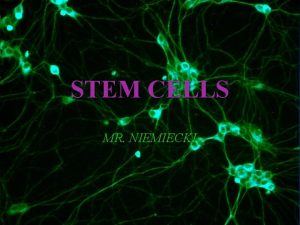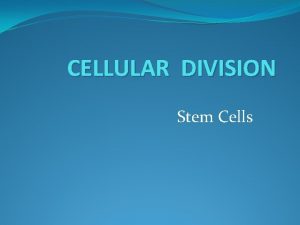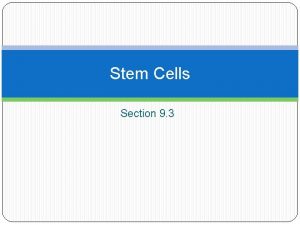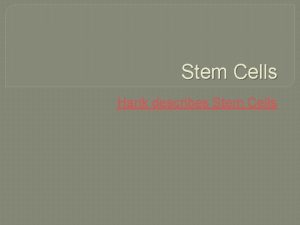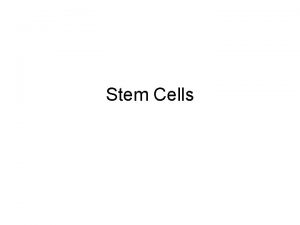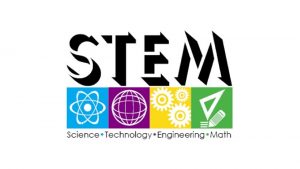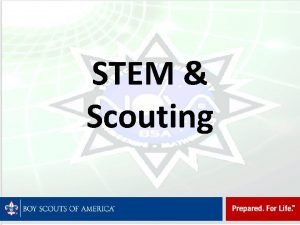Welcome To our Presentation ON Stem cells Stem

























- Slides: 25

Welcome To our Presentation ON Stem cells……

Stem Cells

Stem Cell History 1998 - Researchers first extract stem cells from human embryos 1999 - First Successful human transplant of insulinmaking cells from cadavers 2001 - President Bush restricts federal funding for embryonic stem-cell research 2002 - Juvenile Diabetes Research Foundation International creates $20 million fund-raising effort to support stem-cell research 2002 - California ok stem cell research 2004 - Harvard researchers grow stem cells from embryos using private funding 2004 - Ballot measure for $3 Billion bond for stem cells

Stem. Cell –– Definition A cell that has the ability to continuously divide and differentiate (develop) into various other kind(s) of cells/tissues

Stem Cell Characteristics • ‘Blank cells’ (unspecialized) • Capable of dividing and renewing themselves for long periods of time (proliferation and renewal) • Have the potential to give rise to specialized cell types (differentiation)

Kinds of Stem Cells Embryonic stem cells five to six-day-old embryo Tabula rasa Embryonic germ cells derived from the part of a human embryo or fetus that will ultimately produce eggs or sperm (gametes). Adult stem cells undifferentiated cells found among specialized or differentiated cells in a tissue or organ after birth appear to have a more restricted ability to produce different cell types and to self-renew.

Kinds of Stem Cells Embryonic stem cells five to six-day-old embryo Tabula rasa Embryonic germ cells derived from the part of a human embryo or fetus that will ultimately produce eggs or sperm (gametes). Adult stem cells undifferentiated cells found among specialized or differentiated cells in a tissue or organ after birth appear to have a more restricted ability to produce different cell types and to self-renew.

Pluripotent Stem Cells – more potential to become any type of cell

Multipotent stem cells • Multipotent stem cells – limited in what the cells can become

Embryonic Stem Cells

Adult Stem Cells An undifferentiated cells found among specialized or differentiated cells in a tissue or organ after birth Skin Fat Cells Bone marrow Brain Many other organs & tissues

Induced Pluripotent Stem Cells

Bone Marrow • Found in spongy bone where blood cells form • Used to replace damaged or destroyed bone marrow with healthy bone marrow stem cells. • treat patients diagnosed with leukemia, aplastic anemia, and lymphomas • Need a greater histological immunocompatibility

Umbilical cord stem cells • • • Also Known as Wharton’s Jelly Adult stem cells of infant origin Less invasive than bone marrow Greater compatibility Less expensive

Umbilical cord stem cells Three important functions: 1. Plasticity: Potential to change into other cell types like nerve cells 2. Homing: To travel to the site of tissue damage 3. Engraftment: To unite with other tissues

Stem Cell Applications • Tissue repair - nerve, heart, muscle, organ, skin • Cancers • Autoimmune diseases - diabetes, rheumatoid arthritis, MS

Tissue Repair • Regenerate spinal cord, heart tissue or any other major tissue in the body.

Heart Disease • Adult bone marrow stem cells injected into the hearts are believed to improve cardiac function in victims of heart failure or heart attack


Stem cells in the adult brain:

Problems with Adult Stem Cells

Stem cells in mature skeletal muscle: Is there power still in our stem cells?

What is stem cell research? • Understand more about development, aging, disease Experimental model systems Prevent or treat diseases and injuries • Cell-based therapies Pharmaceutical development Includes testing and drug delivery

Why is Stem Cell Research So Important to All of Us? • Stem cells can replace diseased or damaged cells • Stem cells allow us to study development and genetics • Stem cells can be used to test different substances (drugs and chemicals)

Thank you for watching BY: - MADHULA & MADHURI 2 nd B. Sc(B. G. B)
 Wise men three clever are we
Wise men three clever are we Welcome to our presentation
Welcome to our presentation Welcome to our presentation
Welcome to our presentation Slidetodoc.com
Slidetodoc.com Welcome to our group presentation
Welcome to our group presentation Welcome to our presentation
Welcome to our presentation Pns water view position
Pns water view position Proximal convoluted tubule
Proximal convoluted tubule Parafollicular cells vs follicular cells
Parafollicular cells vs follicular cells Haploid vs diploid venn diagram
Haploid vs diploid venn diagram Why dna is more stable than rna?
Why dna is more stable than rna? Chlorocruorin
Chlorocruorin Prokaryotic v eukaryotic
Prokaryotic v eukaryotic Plant and animal cells venn diagram
Plant and animal cells venn diagram Prokaryotic cell
Prokaryotic cell Organelle trail
Organelle trail Masses of cells form and steal nutrients from healthy cells
Masses of cells form and steal nutrients from healthy cells Label
Label 4 types of eukaryotic cells
4 types of eukaryotic cells Which organisms are prokaryotes
Which organisms are prokaryotes Nondisjunction in meiosis
Nondisjunction in meiosis Cells cells they're made of organelles meme
Cells cells they're made of organelles meme Where can scientists obtain stem cells? *
Where can scientists obtain stem cells? * Pluripotent stem cells examples
Pluripotent stem cells examples Stem cells
Stem cells Conclusion of stem cells
Conclusion of stem cells






















